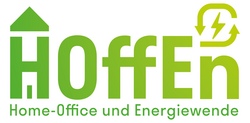Home-Office and energy transition: Implications of mobile working and opportunities for the transition of the energy system Electricity consumption, mobility behavior and rebound effects
Due to the Corona pandemic, there has been movement in the perception and use of home office and teleremote working. In this joint project, the energetic and non-energetic implications of this change that are relevant for the energy transition are investigated. Shifting work to the home office has an impact on energy consumption, particularly in the subsectors of electricity, mobility, heating and other consumption.
The objectives of this project are on the one hand to analyze the future effects of the change from the classic working environment to the home office on energy consumption. Furthermore, it is to be determined under which boundary conditions this change can be used in the implementation of the energy transition. Subsequently, recommendations shall be derived for practical actors (individuals, companies, and politics) in order to be able to design home offices in a way that is conducive to health and contributes to the energy transition.
To achieve these goals, the changes in energy consumption will first be estimated for the sub-areas of "digital infrastructure/electricity," "buildings" and "mobility" based on models to determine potential energy savings. The project will also examine in greater detail the energy rebound effects that can arise in the course of efficiency measures in the three subsectors. With an expansion of mobile working, a central question is the acceptance of this form of working as well as its effect in the non-energy area. Therefore, another focus is the analysis of effects on health, acceptance and productivity of the new forms of work. The obtained results in the sub-areas are summarized in an overall model and are simulated in a simplified way for different scenarios. Finally, the results obtained will be used to derive recommendations for action for companies as well as for political actors for optimizing the proportion of home offices, adapting office space and workplaces, controlling heating and cooling, training employees, and identifying new living space requirements.
IÖW Project Team
- Clara Lenk
- Nesrine Ouanes
- Dr. Julika Weiß




